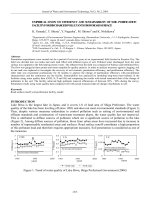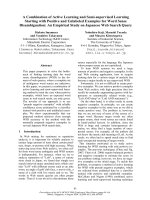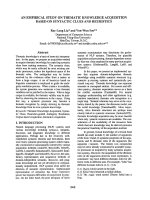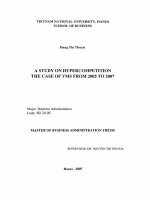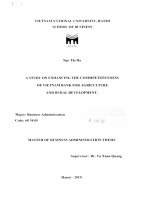An empirical study on measuring the success of knowledge repository systems
Bạn đang xem bản rút gọn của tài liệu. Xem và tải ngay bản đầy đủ của tài liệu tại đây (248.58 KB, 83 trang )
AN EMPIRICAL STUDY ON MEASURING THE
SUCCESS OF KNOWLEDGE REPOSITORY SYSTEMS
BY
QIAN ZHIJIANG
(B.S. in Computer Science, Nanjing University, P.R. China)
A THESIS SUBMITTED
FOR THE DEGREE OF MASTER OF SCIENCE
DEPARTMENT OF INFORMATION SYSTEMS
NATIONAL UNIVERSITY OF SINGAPORE
2004
Acknowledgement
Many people contributed to the delivery of this thesis. I am grateful to all of them who
helped me throughout my study and research.
First, I would like to express my gratitude and appreciation to my supervisor Dr. Bock
Gee Woo, for his invaluable insights and constant encouragement. He has given me
dedicated and committed guidance at every stage of my research. This piece of work
could not be done without him.
I am also indebted to Dr. Xu Yunjie for his helpful guidance and useful suggestions
during the study. I have learned a lot from him, especially on quantitative research
methodology.
Friends at the KM lab have given me many insightful comments on my research. I
would like to thank them for their help, encouragement, and companionship, which
have made my experience here enjoyable.
Last but not least, I must thank my parents for their unselfish love and ceaseless
encouragement. They are always supportive of me in all my endeavors, through my
success and failures. I dedicate this work to my beloved parents.
ii
Summary
As knowledge has been regarded as the most important resource to produce long-term
sustainable competitive advantages for organizations, Knowledge Management (KM)
and Knowledge Management Systems (KMS) are of great interest to academics as well
as to practitioners. However, despite heavy investments in the KMS such as
Knowledge Repository Systems (KRS), their success has been rarely measured. Due to
the unique nature of knowledge and knowledge management, the well-cited DeLone
and McLean’s Information Systems (IS) success model, which was developed for a
more traditional IS context, may not be entirely adequate for measuring KMS success.
This study focuses on KRS, a kind of KMS which follows a codification strategy, and
presents a more comprehensive KRS success model.
Our model is based on Manson’s information measurement framework, combining
DeLone and McLean’s IS success model and Markus’s knowledge reusability concept.
We suggest that KRS success should be measured at each stage of knowledge reuse as
well as its influence on knowledge users. In additional, we argue that these success
dimensions are interrelated and hypothesize their relationships.
In order to validate the proposed KRS success model, an empirical study was
conducted among 110 KRS users in China and Singapore. Reported results provide
preliminary support for our model and indicate the multidimensional and
iii
interdependent nature of KRS success as well as the uniqueness of KRS to other
information systems. Besides the relationships demonstrated and validated in DeLone
and McLean’s model, we find success in knowledge acquisition, which includes
nurturing trust climate in the organization and motivating employees intrinsically to
contribute their knowledge into repositories, and knowledge refinement leads to high
output quality of KRS. The findings of this study offer organizations a set of guidelines
in evaluating and predicting the success of complex KRS.
iv
List of Figures
FIGURE 1. DELONE AND MCLEAN’S IS SUCCESS MODEL ........................... 11
FIGURE 2. CONCEPTUAL DIAGRAM ............................................................. 22
FIGURE 3. RESEARCH MODEL ..................................................................... 24
FIGURE 4. RESULTS OF PLS ANALYSIS ........................................................ 51
v
List of Tables
TABLE 1. RESEARCH CONSTRUCTS ............................................................. 39
TABLE 2. PROFILE OF ORGANIZATIONS ....................................................... 41
TABLE 3. SUMMARY STATISTICS FOR MEASURES OF THE SURVEY ............... 45
TABLE 4. CORRELATION BETWEEN CONSTRUCTS ........................................ 49
TABLE 5. HYPOTHESES TEST RESULTS ........................................................ 52
vi
Table of Contents
ACKNOWLEDGEMENT........................................................................................... II
SUMMARY .................................................................................................................III
LIST OF FIGURES ..................................................................................................... V
LIST OF TABLES.......................................................................................................VI
TABLE OF CONTENTS.......................................................................................... VII
CHAPTER 1. INTRODUCTION................................................................................ 1
1.1 RESEARCH BACKGROUND ...................................................................................... 1
1.2 RESEARCH OBJECTIVES .......................................................................................... 4
1.3 THESIS ORGANIZATION ........................................................................................... 5
CHAPTER 2. LITERATURE REVIEW .................................................................... 6
2.1 MEASURING THE SUCCESS OF KMS ....................................................................... 6
2.1.1 KMS Success Measurement in Practice.......................................................... 6
2.1.2 Research on KMS Success Measurement........................................................ 8
2.2 DELONE AND MCLEAN’S IS SUCCESS MODEL ....................................................... 9
2.2.1 Theoretical Foundations ............................................................................... 10
2.2.2 Empirical Studies ...........................................................................................11
2.2.3 Critical Analysis............................................................................................ 13
2.3 KNOWLEDGE REPOSITORY SYSTEMS .................................................................... 15
2.4 KNOWLEDGE REUSE PROCESS .............................................................................. 17
2.4.1 Knowledge Acquisition ................................................................................. 17
2.4.2 Knowledge Refinement ................................................................................. 18
2.4.3 Knowledge Distribution................................................................................ 19
2.4.4 Knowledge Reuse .......................................................................................... 20
CHAPTER 3. RESEARCH MODEL........................................................................ 21
3.1 CONCEPTUAL DIAGRAM AND RESEARCH MODEL ................................................. 21
3.2 RESEARCH VARIABLES AND RESEARCH HYPOTHESES .......................................... 24
3.2.1 Dependent Variables ..................................................................................... 24
3.2.2 Output Quality .............................................................................................. 28
3.2.3 Independent Variables................................................................................... 30
CHAPTER 4. RESEARCH METHODOLOGY...................................................... 36
4.1 MEASURES............................................................................................................ 36
4.2 SURVEY ADMINISTRATION .................................................................................... 39
4.3 ANALYTICAL PROCEDURES ................................................................................... 41
CHAPTER 5. DATA ANALYSIS AND RESULTS .................................................. 44
5.1 VALIDITY OF INSTRUMENT .................................................................................... 44
vii
5.1.1 Content Validity............................................................................................. 44
5.1.2 Reliability...................................................................................................... 44
5.1.3 Construct Validity.......................................................................................... 47
5.1.4 Multicollinearity Test .................................................................................... 50
5.2 TESTING THE STRUCTURAL MODEL ...................................................................... 50
CHAPTER 6. DISCUSSION AND IMPLICATIONS ............................................. 54
6.1 DISCUSSION OF RESULTS ...................................................................................... 54
6.2 LIMITATIONS ......................................................................................................... 57
6.3 IMPLICATIONS ....................................................................................................... 58
CONCLUDING REMARKS ..................................................................................... 62
REFERENCES............................................................................................................ 63
APPENDIX A: QUESTIONNAIRE ITEMS ............................................................. A
APPENDIX B: PRINCIPAL COMPONENTS FACTOR ANALYSIS RESULTSC
viii
Chapter 1. Introduction
Chapter 1. Introduction
Knowledge Management Systems (KMS) and Information Systems (IS) Success are
gaining increasing popularity in IS research area. This thesis attempts to contribute to
these two streams of research by probing into success dimensions of KMS. Specifically,
it presents a more comprehensive success model for Knowledge Repository Systems
(KRS) by combining DeLone and McLean’s IS success model with knowledge reuse
process. This chapter provides an overall understanding of this study. It illustrates the
research background first. Then it presents the study objectives, followed by thesis
organization.
1.1 Research Background
The resource-based view of the firm defines organizational strategic assets as being
valuable, rare, imperfectly imitable, and nonsubstitutable to sustain competitive
advantages (Wernerfelt, 1984; Michalisn et al., 1997). Recently, the emerging
knowledge-based view of the firm considers that knowledge is the firm’s most
important strategic assets because it represents intangible resources that are
unpurchasable and hard to imitate (Grant, 1996; Spender, 1996). With the increasing
attention on knowledge as an important weapon for sustaining competitive edge, there
is a growing awareness of the importance of having a structured and systematic
approach to what is being known as Knowledge Management (KM) and KM is rapidly
becoming an integral business function for many organizations.
1
Chapter 1. Introduction
Information and communication technologies have been proposed as effective tools to
support KM, in form of Knowledge Management Systems (KMS). IT has challenged
the old inefficient methods of managing knowledge and facilitated organizational
processes of knowledge creation, storage/retrieval, transfer, and application (Arora,
2002). Alavi and Leidner (2001) define KMS as “a class of information systems
applied to managing organizational knowledge”.
As knowledge has been recognized as an organization’s source of sustainable
competitive advantages, KM and KMS are of great interest to academics, as well as to
practitioners. This is evidenced by the fact that more and more businesses have
embarked upon implementing KMS. In parallel, there is the increasing body of
literature on the subject of KM/KMS.
Another topic with rapidly expanding interest within the Information Systems (IS)
research community is that of IS success and effectiveness, which is an important
phenomenon for both researchers and practitioners. After considerable resources are
invested by organizations in IS, organizations need evidence to justify the investment.
Without measurable success, enthusiasm and support for IS are unlikely to continue.
To measure the success of IS, it has been proposed to compute the contribution of IS to
organizational performance (Gelderman, 1998), especially in monetary terms and
traditional investment analysis techniques and criteria, such as return on investment,
2
Chapter 1. Introduction
net present value, or payback period could be used. But in real practice, successful
financial measurement of IS contribution is hard to achieve, because a large portion of
costs and benefits of IS will be qualitative or intangible and confounding factors often
make it difficult to ascertain the influence of IS implementation (Scott, 1995; Grover et
al., 1996; Gelderman, 1998).
Partially due to the difficulty of direct measurement, subjective judgment and
surrogate measures gain acceptance. Two of the best known of these scales are usage
the User (Information) Satisfaction (Ives et al., 1983; Baroudi et al., 1986), both are
supposed to be proxies for IS success. The rationales behind the application of usage
and UIS as IS success measures are the ideas that IS do not contribute to performance
if they are not used and their effectiveness is presumed to increase user satisfaction
(Scott, 1995; Geldman, 1998). Despite their prominence, these two measures have also
been widely criticized. (Srinivasan, 1985; Galetta et al., 1989; Saarinen 1996; Grover
et al., 1996). One of the main criticisms is their narrow scope. Some researchers argue
that it is questionable whether they cover all essential issues related to the success of IS.
The IS success is not only a multi-item, but a multi-dimensional concept (Saarinen,
1996). Other criteria, such as information quality and organizational impact, although
less-explored, should be included in the measurement framework. Another problem of
these two measures is poor theoretical base. “Theory and measurement issues are often
intertwined and having one makes it easier to develop or better understand the other.”
(McLean et al., 2002) But application of usage and UIS lacks an overarching
3
Chapter 1. Introduction
framework grounded on theories regarding the context with which effectiveness
criteria are applied (Grover, 1996).
DeLone and McLean (1992) analyzed all the different streams of research about IS
success and proposed an integrated IS success model. This model based on Shannon
and Weaver’s (1949) theory of communication and Mason’s (1978) information
influence theory, highlights the multidimensional and interdependent nature of IS
success. Due to the fact that it is comparably comprehensive, well-defined, and
theoretically founded, DeLone and McLean’s model is probably the one enjoying most
wide acceptance. For instance, in Garrity and Sanders’s (1998) book Information
Systems Success Measurement, eight out of nine papers refer to, and make use of, the
DeLone and McLean’s model.
As KMS continue to grow in volume and importance to organizations, the need for
KMS success measurement and evaluation also escalates. However, for KMS, a special
kind of IS, their success has been rarely measured. Due to the unique nature of
knowledge and knowledge management, KMS success measurement is even more
difficult than that of traditional information systems and regarded as a critical issue
which is left unsolved, yet is essential for effective KM implementation (Garvin,
1993).
1.2 Research Objectives
4
Chapter 1. Introduction
Combining these two popular research streams: KMS and IS success, within the
context of Knowledge Repository Systems (KRS), this study attempts to investigate
the success dimensions of KRS and their relationships by integrating the generic
framework of DeLone and McLean’s IS success model with Markus’s (2001)
knowledge reusability process based on Manson’s (1978) information influence theory.
We expect to develop a more comprehensive framework for KRS success
measurement and suggest the issues which organizations should tackle to measure and
improve the success of KRS.
1.3 Thesis Organization
The remainder of the thesis is organized as follows: chapter 2 reviews the relevant
literature on pervious studies on KMS success, knowledge repository systems along
with DeLone and McLean’s model and knowledge reuse process which provide
theoretical foundations for this study. Based on extant literature, the theoretical
framework, research model and hypotheses are presented in chapter 3. In Chapter 4,
the research method is described and definitions of variables and their measurements
are developed. Chapter 5 reports and analyses the results of empirical study. Chapter 6
interprets theses results and discusses the contributions and limitations of this research.
Finally, we present the concluding remarks.
5
Chapter 2. Literature Review
Chapter 2. Literature Review
This chapter presents a brief literature relevant to the present study. It begins with
reviewing previous studies on KMS success measurement. The next section covers
DeLone and McLean’s (1992) IS success model, including its theoretical background
and its strength and weakness when applied to KMS success. Then the introduction to
Knowledge Repository Systems (KRS) is given. Finally, we discuss Markus’s (2001)
knowledge reuse process to illustrate how knowledge is reused in knowledge
repositories.
2.1 Measuring the Success of KMS
Since implementing KMS requires significant financial investment and management
effort, it is necessary for managers to measure the success of such systems, which
provides a basis for company valuation, stimulates management to focus on what is
important, and justifies investment in KM initiatives (Turban and Aronson, 2001). But
practice and research on KMS measurement still remain as challenges and are not well
developed (KanKanhalli and Tan, 2004).
2.1.1 KMS Success Measurement in Practice
In practice, because the costs and the benefits of implementing KM initiatives are
notoriously hard to pin down, it is difficult to apply the traditional financial metrics
such as ROI and payback time to KM programs. At early stage of KM, there was only
6
Chapter 2. Literature Review
anecdotal evidence about the benefits and success of implementing KMS. To meet the
requirements of organizations for more systematic approaches to evaluate the success
of KMS, KM consultants, vendors, and practitioners have proposed some measurement
models which are increasingly used in organizations. From a practitioner’s perspective,
a KMS is an integrative part of a whole KM initiative and their biggest concern is the
final results of implementing KMS (i.e. benefits to organizations), therefore measuring
KMS success is often equivalent to measuring the effectiveness of KM initiatives.
The balanced scorecard (BSC) developed by Kaplan and Norton (1992) is one of the
most popular performance measurement models. Some practitioners extended BSC to
KM metrics to look at KM activities from the four scorecard perspectives: financial,
customer, internal process, and learning (Foster, 1999; Roberts, 2001). Others took a
perspective of knowledge assets to study KM success by measuring the value of
intellectual capital (Bontis, 2001; Liebowitz and Suen, 2000). The most famous and
widely used models include Skandia Navigator (Edvinsson and Malone, 1997) and
IC-index (Roos et al., 1998). Some organizations suggested that KM effectiveness
measurement should be tied to the maturity of KM initiatives, which progresses
through a series of phases (Lopez, 2001). APQX (American Productivity and Quality
Center) outlined a measurement plan for each stage of the KM implementation.
However, KM practitioners narrowly focus on measuring the outcomes of
implementing KMS and these measures lack theoretical grounding of causal and
process models of KM/KMS success.
7
Chapter 2. Literature Review
2.1.2 Research on KMS Success Measurement
In the academic community of IS research, the literature on KMS success
measurement is mainly in the form of individual case study, and only limited studies
devoted to the development of the generalizable KMS success models (KanKanhalli
and Tan, 2004). Some researchers (e.g. Wasko and Faraj 2000, Jarvenpaa and Staples
2000) measured KMS at the user level to evaluate the motivation of users to contribute
and seek knowledge, as well as the consequent usage of KMS (KanKanhalli and Tan,
2004). But these studies only focus on user involvement and lack an integrated view to
provide an in-depth analysis of KMS success.
Jennex and Olfman (2003) applied DeLone and McLean’s model to KMS to evaluate
the success in terms of system quality, knowledge quality, use/user satisfaction,
perceived benefit, and net benefits. Furthermore, they identified three independent
constructs : the technological resources of the organization, the form of the KMS, and
the level of the KMS to measure system quality; in information/knowledge quality,
they included richness and linkage, which are affect by knowledge strategy/process.
After reviewing relevant studies on KM success, they concluded that compared with
other KM success models, this model, based on solid theoretic foundation, meets KMS
success criteria better (Jennex and Olfman, 2004). Maier (2002) also selected DeLone
and McLean’s model as the basis for KMS success and extended it by adding two
constructs: knowledge-specific service and impact on collectives of people. Although
8
Chapter 2. Literature Review
both Maier (2002), and Jennex and Olfman (2003; 2004) argued that DeLone and
McLean’s model is an appropriate theoretic basis for KMS success measurement and
proposed their measurement models, neither of them conducted empirical study to test
their models. In addition, much of the literature does not consider the fact that the
effective functioning of KMS is associated with ongoing use as well as the initial
adoption of the technology (Huber, 2001) and fails to take a process-oriented
perspective of organizational knowledge to look into the steps by which knowledge is
managed in organizations.
To fill this gap, the study presented here seeks to enhance the existing knowledge
about KMS success by combining DeLone and McLean’s model with knowledge reuse
process in KRS context and empirically testing the proposed KRS success model.
2.2 DeLone and McLean’s IS Success Model
After reviewing 100 papers containing empirical IS success measures that had been
published in seven publications during the 1981-1987, Delone and Mclean proposed
six major dimensions of IS success: System Quality, Information Quality, Use, User
Satisfaction, Individual Impact, and Organizational Impact. Moreover, they suggested
these dimensions are interrelated and interdependent, forming an IS success model.
This model not only provides a scheme for classifying the multitude of IS success
measures, but also suggests the temporal and causal interdependencies between these
categories, making an important contribution to the literature on IS success
9
Chapter 2. Literature Review
measurement (Seddon 1997; Seddon et al., 1999; McGill and Hobbs, 2003).
2.2.1 Theoretical Foundations
The underlying theoretical foundation which DeLone and McLean use as a basis for
their derivation of the IS success model is the work of Shannon and Weaver (1949) and
Mason (1978). Shannon and Weaver (1949) classified the communication problems
into three hierarchical levels: the technical level, which concerns how well the system
transfers the symbols of communication; the semantic level, which relates to the level
of success in interpreting the desired meaning of the sender by the receiver; and the
effectiveness level, which is about the effect of the information on the receiver’s actual
behavior. Manson (1978) adapted and extended Shannon and Weaver’s three-level
model to an IS context. In his information influence theory, he presented a framework
for measuring an information system from four levels: technical level, semantic level,
functional level, and influence level. Manson argued that in an information system, it
involves “the means by which one system, the producer P, affects another system, the
receiver R.” (p. 231) Based on the three levels of communication theory, an output
flow from the producer P to the receiver R can be measured. He relabeled
“effectiveness” as “influence” and presented this level as a series of events that take
place at the receiver system R including receipt of information, influence on recipient
and influence on system. Moreover, in order to measure the effectiveness of producer
system P, Mason added a fourth level – functional level to “analyze information output
in terms of the processes which produce it.”
10
Chapter 2. Literature Review
Based on Manson’s measurement framework, DeLone and McLean (1992) categorized
the empirical IS success measures collected from seven top publications into six
dimensions. According to DeLone and McLean’s taxonomy, System Quality belongs to
the technical level, Information Quality belongs to the semantic level, and Use, User
Satisfaction, and impact belong to influence (effectiveness) level. But they did not
include functional level in the model. The hierarchy of levels provides a basis for the
temporal and causal interdependencies between these six dimensions (Figure 1.).
Figure 1. DeLone and McLean’s IS Success Model
(DeLone and McLean 1992, Figure 2, p.87)
2.2.2 Empirical Studies
DeLone and McLean’s IS success model, which systematically combines individual IS
success measures, reflects multidimensional and interdependent nature of IS success. It
is contended:
11
Chapter 2. Literature Review
“System quality and information quality singularly and jointly affect both use and user
satisfaction. Additionally, the amount of use can affect the degree of user satisfaction positively or negatively - as well as the reverse being true. Use and user satisfaction
are direct antecedents of individual impact; and lastly, this impact on individual
performance should eventually have some organizational impact.” (DeLone and
McLean, 1992, p.83)
This relational model is one of the most comprehensive and widely cited IS assessment
model offered by IS research (Garrity and Sanders, 1998; Gable, 2003; Heo and Han,
2003). Yet Delone and Mclean did not provide empirical validation of the model and
emphasized that additional research is required to authenticate the model’s validity.
Since the publication of this model, a number of studies have undertaken empirical
investigations of the proposed interrelationships among the measures of IS success.
Many researchers have adopted this model to study different kinds of information
systems, such as decision support systems (McGill, 2003), e-commerce (Molla and
Licker, 2001; DeLone and McLean, 2003), integrated student information systems (Rai
et al., 2003), data warehousing (Wixom and Watson, 2001; Shin, 2003), accounting
information systems (Seddon and Kiew, 1996), and enterprise systems (Gable, 2003).
These empirical studies provide strong support for the suggested associations among
the IS success constructs and help to confirm the causal structure in the model
(DeLone and McLean, 2003).
12
Chapter 2. Literature Review
Despite the huge and growing interest in KMS in IS research, there is a surprising
paucity of empirical research on adopting DeLone and McLean’s model to KMS to
investigate the success dimensions and their interrelationships. Maier (2002) and
Jennex and Olfman (2003) are among the first to apply DeLone and McLean’s model
in KMS context. But they just proposed their KMS success models and did not test
them empirically.
2.2.3 Critical Analysis
Despite a lot of theoretic and empirical validations and wide popularity of DeLone and
McLean’s model, several articles have been published that challenge and critique this
model. A number of researches which employ this model suggest the incompleteness
of this model in certain areas (Garrity and Sanders, 1998). For example, Li (1997)
argued that it is deficient that the six dimensions of DeLone and McLean’s model
encompass only the system aspect of IS success and overlook the human one. Seddon
and Kiew (1996) suggested that system importance is an important factor which should
be included in the model. These critical assessments expose the need for a broader
model when adopting it to KMS. Just as DeLone and McLean (1992) mention, this
success model clearly needs further development when applied in specific research
contexts.
Although Delone and Mclean (1992) argued that “Mason’s adaptation of
communication theory to the measurement of information systems suggests that there
13
Chapter 2. Literature Review
may need to be separate success measures for each of the levels of information,” (p.62)
their model only measures technical success, semantic success, and effectiveness
success of an information system, and does not include the functional level explicitly.
When DeLone and McLean developed their model in early 1990s, information systems
typically included those which processed many routine transactions, such as payrolls,
stock controls and invoices. For the transactional information systems, the focus was
on automating the information process functions where they could make large
efficiency gains. These functions such as sorting or calculating were completed by
machines. So it is reasonable for DeLone and McLean to exclude functional level and
just measure system quality in the technical level, which has covered the information
production process. However, after the introduction of KMS, and KRS in particular,
the processes which produce the output are not only a technical issue. Advanced
distributed technologies, such as Lotus Notes or intranets, can be useful for
disseminating information. But they are not enough for a successful KM program
which involves a lot of human intervention (Cross and Baird, 2002). Therefore, IS
managers and researchers cannot limit their attention to only the hardware and
software components ignoring the effects of the people or motivational problems on
the performance of KMS. This suggests that DeLone and McLean’s model which was
developed for a more traditional IS context may not be entirely adequate for measuring
KMS success. In order to study the success of KRS, there is a need to supplement
DeLone and McLean’s model by including the function level separately and explicitly
in the success model to analyze the processes which produce the knowledge in the
14
Chapter 2. Literature Review
repositories.
2.3 Knowledge Repository Systems
Previous studies explicate two dimensions of knowledge in organizations: tacit
knowledge, which is deeply embedded in the human brain and hard to formalize and
communicate, and explicit knowledge, which is transmissible in a codified form
(Nonaka and Tackeuchi, 1995; Alavi and Leidner, 2001). Related to this dichotomy of
knowledge are two KM strategies which involve an organization’s primary approach to
knowledge transfer: personalization and codification (Hansen et al., 1999). With the
personalization strategy, knowledge is shared mainly through person-to-person contact.
In the codification strategy, knowledge is carefully codified and stored in repositories
where it can be accessed and used easily by anyone in the company. Choosing which
strategy depends on the competitive base of organizations and the fit of the strategy to
their needs (Hansen, et al., 1999; KanKanhalli et al., 2003).
IT plays different roles in these two KM strategies. The codification strategy centers on
IT to store explicit knowledge; while the personalization strategy focuses on direct
interaction among people with the help of IT (Hansen et al., 1999) and the KMS itself
plays a much smaller role than it does in the codification strategy. So the role of IT and
KMS is central to the success of a codification KM strategy, but may be less important
to the success of a personalization strategy (Ko and Dennis, 2002). Therefore, in this
study we choose to focus on KMS that follow the codification strategy, more
15
Chapter 2. Literature Review
specifically Knowledge Repository Systems (KRS).
KRS are key components of codification strategy for knowledge management, which
have been defined by many researchers. Some authors view them as KMS that utilize
IT to capture, organize, store and distribute explicit organizational knowledge
(Bowman, 2002). Others regard a knowledge repository as an online, computer-based
storehouse of expertise, knowledge, experience, and documentation about a particular
domain of expertise (Liebowitz and Beckman, 1998). Huber (2001) described that in
knowledge repository, knowledge originally possessed by one or few people is
deposited into a computer-resident knowledge archive from which it can be
subsequently accessed by many potential users.
Base on previous literatures on KRS, in this study we define the Knowledge
Repository System as:
A kind of KMS that focus primarily on capturing, organizing, storing, and distributing
explicit organizational knowledge, in which people codified their knowledge into
knowledge base for facilitating their colleagues to access and use so as to achieve
economic reuse of knowledge.
KRS users are both knowledge contributors and knowledge seekers. Through
transferring an individual entity to public good, KRS essentially capture knowledge in
16
Chapter 2. Literature Review
forms and through processes that enable access throughout the company (Ruggles,
1998), which contributes to the maintenance of the firm’s shared intellectual assets and
opens up the possibility of achieving scale in knowledge reuse and thus of growing the
business (Hansen et al., 1999).
As one of the best-know approaches to using technology in KM, a lot of energy has
been spent on KRS (Davenport et al., 1998). In a survey on KM in practice by Ruggles
(1998), 57% of respondents reported that the implementation of KRS to be under way
or in the planning stage. Davenport and Prusak (1998) found that 80% of the KM
projects they reviewed involved some form of knowledge repository.
2.4 Knowledge Reuse Process
In KRS, explicit knowledge is stored for later reuse (Zack 1999). By looking explicit
knowledge as a kind of information product and studying the architecture of
information products (Meyer and Zack, 1996), Zack (1999) proposed five stages in the
process for creating and distributing the knowledge in a repository: acquisition,
refinement, storage and retrieval, distribution, and presentation. Similarly, in the theory
of knowledge reusability, with emphasis on knowledge repositories, Markus (2001)
defined the process of knowledge reuse in terms of four steps: capturing knowledge,
refining knowledge for reuse, distributing knowledge, and reusing knowledge.
2.4.1 Knowledge Acquisition
17
